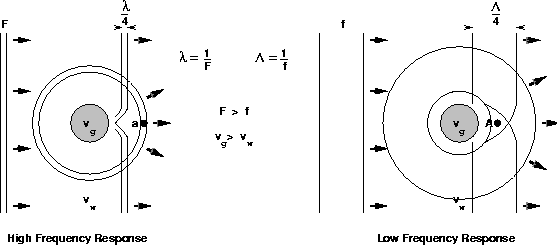




Next: The low frequency-high frequency
Up: P-VELOCITIES FOR DIFFERENT FREQUENCIES
Previous: The Fresnel zone
The idea of the Fresnel zone is useful in understanding when the
the waves diffracted from scattering grains add
constructively and what their relative importance is.
Figure (8) shows two scattering responses of a spherical
grain to different frequencies of the arriving wave at a given
time t. The velocity of the grain, vg, is assumed to
be higher than the velocity of the host medium (water), vw.
The left drawing represents the high-frequency response and shows
that the transmitted plane wave (slightly curved in the proximity
of the grain because of the diffraction effect) is far from the
purely diffracted spherical wave centered on the grain. At a
lower frequency (right drawing), the planar and spherical waves
add constructively in the region around point  . In the
high-frequency case, the point of highest amplitude behind the
grain on the axis of propagation is located on the diffracted
spherical wave, although this is not a zone of constructive
interference (point
. In the
high-frequency case, the point of highest amplitude behind the
grain on the axis of propagation is located on the diffracted
spherical wave, although this is not a zone of constructive
interference (point  on the drawing). The distance ds
from point
on the drawing). The distance ds
from point  (the first point met by the planar wave incident
to the grain) to point
(the first point met by the planar wave incident
to the grain) to point  is
is
|  |
(4) |
where r is the radius of the grain. In the low-frequency case,
the point of highest amplitude behind the grain is not located
exactly on the spherically diffracted wave but is closer to the
center of the grain: the constructive interferences have moved
the point of highest amplitude backward. As a consequence, the
velocity appears higher in the high-frequency measurement
than in the low-frequency measurement.
Freqvel
Figure 8 The scattering response
of a spherical grain to different frequencies of the arriving
wave.






Next: The low frequency-high frequency
Up: P-VELOCITIES FOR DIFFERENT FREQUENCIES
Previous: The Fresnel zone
Stanford Exploration Project
11/17/1997
